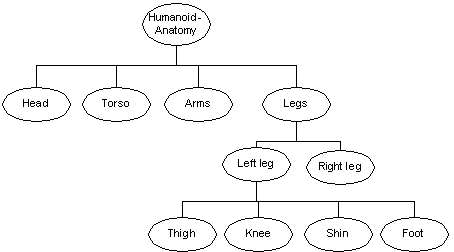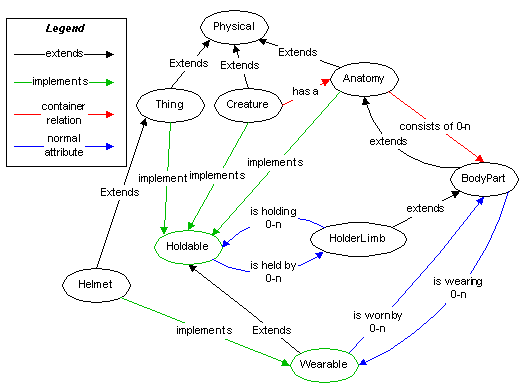
For this purpose there is class called Anatomy. This contains all the information about how a creature is built up, anatomically. It is based on the container hierarchy (as usual) where each body part "contains" other body parts.
The goal is to use this as a basis for clothing, combat, and damage handling in White Orb.

BodyPart getRandomBodyPart(int minSize);
Enumeration getHolderLimbs();
void addDamage(Damage damage); //or something like this
Damage getDamage(); //or something like this
Protection getProtection(boolean total); //or something like this
The getRandomBodyPart method is used to provide a random body part with at least the given size. The size argument is to avoid a catapult stone hitting someone's left eye and dumb things like that. If the minimum size is larger than the Anatomy itself then the Anatomy itself is returned (so a catapult stone CAN hit a mosquito...). Later on we can add functionality for aiming for certain body parts, etc, but for now I want it simple.
getHolderLimbs provides a quick way of accessing all BodyParts that can hold things. For a Humanoid this will return a set of two Hands. For a GiantOctopusAnatomy it might return a set of ten Tentacles...
The getProtection method is used to find out how resistant this body is to damage, usually based on the armour and clothing that it currently worn. If total is false then only the protection of this specific anatomy is included. If total is true then all protection of other BodyParts that are involved is included as well. Let's say I am wearing some kind of elbow plate, and then a heavy coat on top of that. elbow.getProtection(false) will return the protection provided by the elbow plate only, while elbow.getProtection(true) will include the heavy coat, since it protects the elbow indirectly.
The location of a Holdable will always be equal to the owner of the body parts it is being held by.
If you don't know or care exactly how a Wearable is supposed to be worn, just call wear(null). The Wearable will automatically find a nice place to be worn. A helmet would place itself on the head (if there is a head and the head isn't occupied...), a ring would place itself on one of the fingers. Etc.
This is funny. It means a two-headed giant can actually wear two helmets :o)

This means that if Fred is wearing a ring, the ring will be a child of Fred no matter where he is wearing it. It will not be child of his finger. The same goes for stuff he is holding.
When helmet.hold is called the helmet will look at the holdingLimbs parameter. If it is null, the helmet will automatically search through the HolderLimsb (using anatomy.getHolderLimbs()) and place itself in whatever none-occupied hands, tentacles or other HolderLimbs that it can find. If the object is large and must be held by two hands (like a barrel) then it will look for two empy HolderLimbs, etc.
When helmet.wear is called the helmet will look at the coveredBodyParts parameter. If it specifies a head, then it will be worn on that head. If it specifies an arm an ItemHolderException will be generated saying that "NO, bozo, you can't wear the helmet on your &%#¤ ARM! Airhead!". If it doesn't specify anything, the helmet will look through the Anatomy and try to find an unoccupied head. If none are found, an ItemHolderException will be generated.
Well the Arm could be implemented in two ways. Either it keep track of it's own damage, or it actual divides up the damage among it's subparts (elbow, upper arm, hand, etc). When you ask the arm how much damage it has, it will then either simple report it's own damage or sum up the damage of it's children.
What about the hand? Well the hand received 2 damage. If I ask the hand afterwards how much damage it has, it will either return 2 (if the arm didn't spread out the damage) or 2 + something (if the arm spread out the damage among it's children).
The second way may seem cooler, but it may be quite slow. Imagine if a massive fireball hits me and does 40 damage to my actual Anatomy (ie the WHOLE body). This would cause a recursive behaviour downwards until finally only my BodyPart "leaf nodes" will be actually damaged. So instead of my Anatomy registering 40 points of damage, it will give 1 damage to each of my fingers, 2 damage to my elbow, 1 damage to my nose, etc, etc, etc. So it may actually be better to simply register 40 damage in one go.
Another approach is to, when asking the hand how damaged it is, have the hand actually include the damage of it's parent. So the hand reasons "well I have 2 damage, but my parent the arm has 5 damage and 20% of that would apply to me, so my total damage is 3". So even though it internally contains 2 points of damage, it will report 3 points of damage when asked.
I don't know which method is best, but it doesn't really matter since it is the internal matter of the BodyPart classes and won't affect any other classes.
So we can use this design to make both very simple and very complex things.
Last updated: